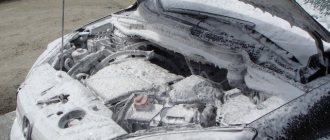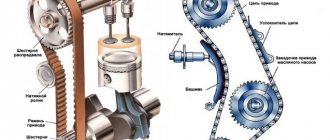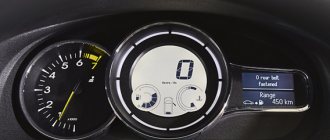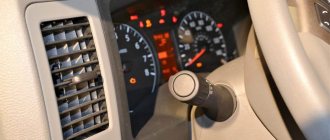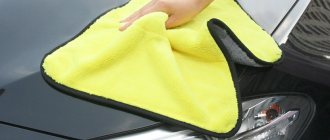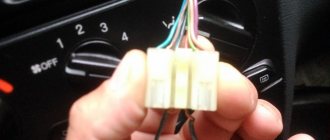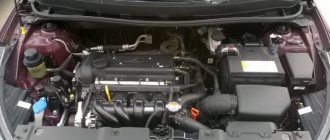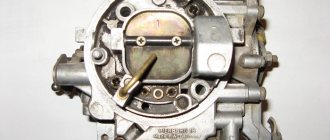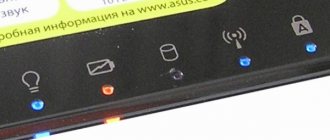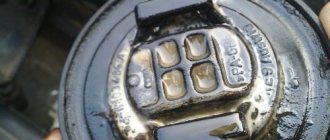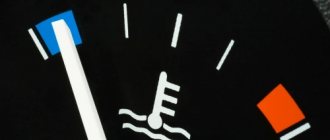Car owners often prefer to wash their car themselves because they are afraid that another person could damage the car. And this is generally correct, since dirt can affect the operation of some systems, and in the future can lead to breakdown.
But for some motorists, it happens that after a car wash the car begins to stall and behave strangely, and sometimes it does not start at all. To prevent something like this from happening in your life, in this article we will look in detail at how to properly and completely wash your car.
First, you need to figure out what the word “triple” means, since not all car owners have heard of this. Troubleshooting is a breakdown of the internal combustion engine, in which one of the 4 cylinders stops working. When a cylinder fails, you will soon feel that the machine is running intermittently. You may also notice that fuel consumption will increase and starting difficulties will arise.
The internal combustion engine may fail for the following reasons:
- When washing, the spark plug tunnels are filled with water, so a spark cannot appear, as a result of which the cylinder cannot function.
- The engine and the entire car were washed under high pressure. The engine should not be washed in this manner as vulnerable parts may be damaged.
- All engine compartment sensors are not very protected, and therefore car shampoo often gets into them, and this leads to engine damage.
To summarize, having considered the reasons described above, we should draw a specific conclusion - you should not wash the entire engine compartment with liquids that are not suitable for this. Because all elements, including the engine, battery, sensors, can only work normally in the absence of moisture.
Moisture in the engine - what to do
Since the car is not able to operate correctly due to moisture ingress, all measures must be taken to eliminate it.
Power wiring
To do this, park the car in a dry, warm place, then wipe off any water from the engine compartment with dry rags. The same procedure must be done with the armored wires of the spark plugs. Next, you should check the terminals in the battery - you need to make sure that they are in perfect order. If you notice that they have turned gray, this indicates severe oxidation. Use fine-grained sandpaper and gradually remove the layer of oxidized metal. Naturally, all this must be done in a de-energized car so that you do not get an electric shock.
Due to moisture, a gray coating has formed on the battery terminals
When humidity is high, a gray coating appears on the battery terminals, which impairs contact. This usually results in the engine being difficult to start. Therefore, if after finishing the washing you find gray deposits on the battery terminals, disconnect them and clean them.
This can be done using WD 40, a stiff brush or rag. Apply the product to the terminals, wait 10 minutes, then wipe with a rag or use a brush.
The car does not start after washing - reasons
Quite often, after visiting a professional car wash, the owner begins to have problems with the car, for example, the engine runs intermittently or the car does not start at all. Moreover, the starter catches, but there is absolutely no benefit from this. How to solve the problem will depend on what kind of car wash was carried out. We will look in more detail at the types of sinks and their features.
Washing was carried out only outside
If you washed the outside of the car, a small amount of moisture may still get under the hood. This is not so critical, so such moisture can be easily removed with a good absorbent fabric. Sometimes you can remove moisture using a compressor, but in this case the air flow should be directed to the sides, otherwise water will get on the mechanisms - this will only make things worse.
It happens that owners do not pay attention to the smallest details, for example, they did not remove moisture from the battery. Subsequently, when copper and lead come into contact, an oxide is formed, which can cause the contact to completely fail. Removing plaque is very simple - use a wire brush to do this, just don’t forget to tighten the terminals later to eliminate the gap. After this procedure, you should be able to start the car.
What to do if the car was washed under the hood improperly
At many car washes, newbies do not think about the consequences and wash the engine with a high-pressure apparatus - this is unacceptable! The consequences of such a wash will be serious difficulties in the operation of the car.
If it so happens that the car stopped working after washing the engine, then now nothing can be done - you will have to correct the situation. To do this, you need to stock up on dry cotton or other highly absorbent rags. First, pay attention to the most vulnerable places: spark plug tunnels, armored wires, as well as the ignition system (especially if it consists of a distributor).
All of the above is the most important procedure for removing fluid from car systems.
Of course, it may also happen that even after thoroughly drying the engine compartment, the car does not start. In this case, there is a possibility of damage to one or another part of the motor, for example, from a strong jet pressure. In this case, the best solution would be to contact a car service and diagnose the car.
Afterword
It is important to remember that you should not wash the engine compartment with a high-pressure cleaner! The fact is that excessive pressure can break or knock out certain parts of the engine compartment, or push water into hard-to-reach places in the engine that will be difficult to reach.
The usual pressure from the tap or a simple bucket of water will be enough. And in order to remove complex contaminants, you can use chemicals. The main thing is not to overdo it, because everything is good in moderation - if you overdo it, then chemicals will also lead to unpleasant consequences, for example, they will oxidize contacts.
Jerks during acceleration, blinking check
If the car jerks after washing, this indicates a combustion problem in one or several cylinders at once. The malfunction most often manifests itself during sudden acceleration or driving under load and is often associated with a malfunction in the ignition system. Since misfires lead to the release of unburned fuel into the atmosphere, the OBD2 protocol suggests a characteristic way of signaling misfires - a blinking Check Engine icon. In this case, the self-diagnosis system stores the following fault codes in memory:
- P0300 – multiple misfires detected. The fault code indicates a chaotic combustion disorder in several cylinders at once;
- P0302 – misfire in the second cylinder;
- P0303 – misfire in cylinder #3;
- P0304 – misfire in the fourth cylinder.
All engines have a unified method for displaying combustion problems using diagnostic code P030n, where n is the cylinder serial number.
When reading fault codes, you should understand that errors are recorded by uneven rotation of the crankshaft. The ECU self-diagnosis system is not able to determine whether there is a problem in the ignition system, fuel supply, or whether there is a mechanical defect in the cylinder-piston group. Nevertheless, computer diagnostics greatly simplifies the search for the reason why the engine stalls after washing or the car jerks during acceleration and stalls.
What to do if the car does not start after washing
After washing your car, you find that it does not start, this means only one thing - the wash was carried out with significant violations of the rules.
If this situation occurs to you, then you should not immediately run to a car service center in panic. Firstly, you can do the drying yourself, and secondly, the service center may come up with a few more faults and charge you more money. You should contact a car service center only when you are absolutely sure that you have thoroughly dried and wiped the engine compartment.
The engine does not start due to the fact that moisture has entered individual components that are not very well protected from moisture. Systems can function fully and correctly only in a dry state, so it is worth doing everything possible to prevent excess moisture from getting there.
Procedure after washing the car
- Open the hood of the car and carefully examine where the liquid has accumulated.
- It is necessary to wipe the battery terminals and spark plug armored wires dry, then remove water from all other wiring.
- If oxide has already appeared on the terminals, it must be removed with a fine-grained file or sandpaper. Oxidation occurs several times faster if chemicals were used during washing and it got on the battery. Therefore, it is worth thoroughly cleaning and drying the contact points between the wiring and the battery.
- It is better to use a sponge and cotton rag to collect moisture; The good thing about a sponge is that it can collect a significant amount of liquid in hard-to-reach places.
- After the water has been removed from all the nodes described above, the problem areas should be thoroughly dried. For this you can use, for example, a hair dryer; it is only important not to overdo it and not to melt the insulation. Therefore, you should not bring the hair dryer too close to the area to be dried.
If you have removed all the fluid from the engine compartment, but the symptoms of the problems recur soon, then most likely the problem was not in the washer. This means that the problem lies elsewhere and you should contact a specialized service for inspection by specialists.
How to solve a problem
Many car enthusiasts may have problems starting the engine after washing, but this is not a reason to panic and immediately contact a service center. The problem can be resolved on your own and in the shortest possible time.
A small amount of moisture getting under the hood during a surface body wash
It is necessary to remove any remaining water.
In this case, it is enough to simply remove moisture from under the hood using a sponge, which absorbs liquid quite well.
Cleaning the battery terminals can give results.
Then you should check the wiring and battery terminals for plaque. If plaque is observed, it is enough to clean the terminal with sandpaper, and then re-tighten the terminal, because Small gaps may form after cleaning.
Water penetration directly into the engine after internal cleaning
The distributor must be disassembled and wiped.
It will be much more difficult to start the engine after washing it with Karcher. Water is supplied under high pressure and is able to penetrate under the distributor cap and into the engine if it has cracks and is not sealed enough. It is best to categorically refuse the offer to knock dirt off the engine using a jet, which is supplied under pressure, in order to avoid serious problems later.
If, after all, the engine was washed in this way, then you need to take some measures to resuscitate the engine and restore all functions. To do this, you should carefully inspect the ignition system, because this is where the possible reason for the “whims” of the engine lies. It is imperative to disassemble, wipe well or blow out the distributor, having first removed the cover from it.
If the system is distributorless, you need to clean the spark plug wells
. The distributorless system will force you to work quite carefully to clean all the spark plug wells. Before doing this, it is necessary to remove all the coils, and some of them are in very hard-to-reach places. The spark plugs must be unscrewed and thoroughly dried so that the spark can ignite the air-fuel mixture. Before this, you need to check them for damage and, if any, replace them with serviceable ones. To avoid short circuits when the engine is running, it is necessary to dry all wires.
All these procedures must be carried out immediately before starting the engine to avoid significant damage due to the presence of moisture in areas that should be completely dry.
If the problem persists and the car does not start, you need to check all the ignition elements, wipe everything well with a dry sponge again and put the car in a warm, dry place for a while.
What to do in rainy weather
If a malfunction occurs in wet weather, the car owner will have to find the reason for this behavior of the car. If you drive your car in the rain, water can also get under the hood. You don’t have to worry - practically no water gets into the engine from simple rain or even downpours, since the pressure is not enough for the water to penetrate.
If there is no power, the first thing to check is the spark plug wells and distributor, as these are the most common places for moisture to enter. After drying these places, most often the car can be started with ease. The situation is completely different if you hit a puddle at high speed, and after that the engine stops starting.
If the car does not start, this may indicate either a slight penetration of water through the hood, or a water hammer. The most serious breakdown is water hammer; this happens extremely rarely and with very serious consequences. The breakdown is that water enters the combustion chamber through the air filter. Water is not compressible, so the consequences are dire, and repairs will cost a lot of money. If water gets into the engine cylinder, it can puncture the cylinder or deform the connecting rod.
We hope that the article was useful to you, and now you know that you should protect the engine compartment from moisture. Otherwise, it may result in serious damage to you. We wish you good roads and many years of driving your car without repairs!
5/5 — (4 votes)
Tips and tricks
As you can see, if the car does not start after washing the engine, there can be quite a lot of reasons, ranging from the most obvious to a breakdown, which is quite difficult to determine on the spot.
On different cars, water may get inside parts, which leads to their failure after a short circuit. In this case, drying the engine and engine compartment is useless, since damaged elements require replacement or repair to start the internal combustion engine.
Please note that if the engine has been washed, then it is necessary to check the engine compartment for moisture accumulation before the engine is started for the first time. In other words, it is better to dry the engine immediately after washing, before starting the unit. This will avoid problems such as burnt ignition coils, short circuits, etc.
We also note that if the culprit of a difficult start is a gray coating on the battery terminals, then after disconnecting the terminals from the battery, this coating dissolves well and is removed with ordinary water. It is enough to pour water onto the terminal and then dry it, instead of taking a long time to remove the deposits with brushes or sandpaper.
